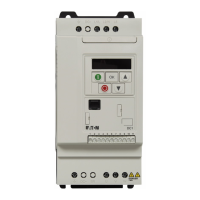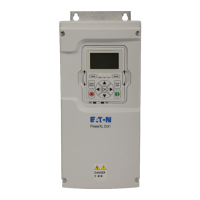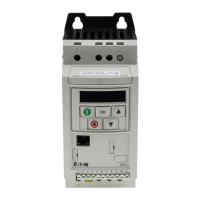2 Engineering
2.3 Safety and switching
34 DC1 variable frequency drive 12/13 MN04020003Z-EN www.eaton.com
2.3.2 Residual current circuit-breaker (RCD)
Residual current circuit-breakers (RCDs = residual current devices) protect
people and farm animals from the presence (not the production of!) imper-
missibly high touch voltages.
They prevent
dangerous
(including fatal) injuries
caused
by electrical accidents and also serve to prevent fires.
Leakage currents to earth are mainly caused by foreign capacities with variable
frequency drives: between the motor phases and the shielding of the motor
cable and via the star capacitor of the radio interference suppression filter.
The size of the leakage currents is mainly dependent upon the:
• length of the motor cable,
• shielding of the motor cable,
• height of the pulse frequency (switching frequency of the inverter),
• design of the radio interference suppression filter
• grounding measures at the site of the motor.
→
Choose the cross-section of the PE conductor in the motor lines
at least as large as the cross-section of the phase conductors
(U, V, W).
CAUTION
Only AC/DC sensitive residual current circuit-breakers (RCD,
type B) should be used with three-phase variable frequency
drives (EN 50178, IEC 755).
→
In the case of variable frequency drives powered with a three-
phase power supply, certain faults may produce DC currents
that will prevent type A RCD protective devices from tripping,
thus rendering the protection they provide ineffective.
→
RCD protective devices must be used exclusively for variable
frequency drives powered with a single-phase (L, N) power
supply.
NOTICE
Residual current devices (RCD) are only to be installed between
the AC supply system and the variable frequency drive.
NOTICE
Safety-relevant leakage currents can occur while handling and
when operating the variable frequency drive, if the variable
frequency drive is not grounded.

